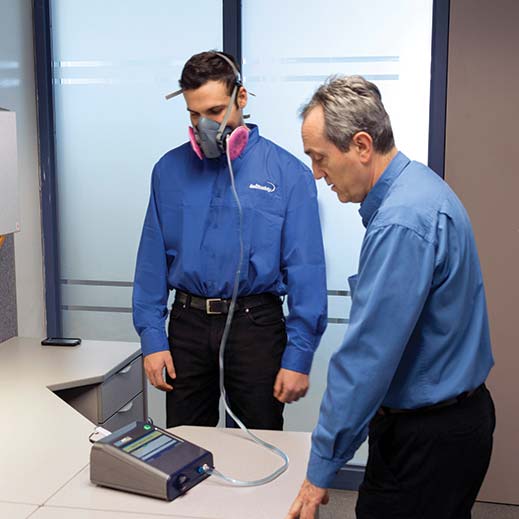10 November 2021 Quantitative Fit Testing
What Is Quantitative Fit Testing And Why Do You Need It?
Filtering Out Confusion
Those who are required to wear respiratory protection throughout the course of their working day are likely to have an idea of Fit Testing and what's involved. For those who don't, ABL Distribution is here to help you understand what it is and why it is so important.Specifically, we will be talking about Quantitative Fit Testing.
ABL Distribution offers Quantitative Fit Testing internally in our showroom, and also externally for certain areas in SEQ. To find out more please click the link here.
So, What Is Quantitative Fit Testing?
Quantitative Fit Testing measures the amount of air leaking through any gaps in the seal of the wearers facepiece.Quantitative testing is much more reliable and accurate when compared to Qualitative testing, this is because it does not rely on ones sense of taste and smell, which may be hindered unbeknownst to the individual themselves or the assessor.
Quantitative testing is performed by a qualified fit test assessor using machines such as PortaCount or Accufit. These machines provide a numerical measurement of the particles inside the mask.
Workers must pass a respirator fit test before they first start wearing a tight-fitting respirator. This test can be done using these machines on the following types of masks:
It is important we take into consideration that everyone's face shape will differ from one another and there is no 'one size fits all'.

The video in the link here demonstrates why Quantitative fit testing results are more objective than qualitative and explains the main differences between the two.
What Is Involved In A Quantitative Fit Test?
Before commencing a fit test, the participant must be clean shaven, and for ladies they must have no makeup on.
Once the respirator is fitted to the participant and the machines are connected to the probe that is attached to the facepiece, a series of light exercises are performed, those of which replicate movements that are made throughout a general working day that may challenge the seal of the respirator. These include:
- Bending over
- Jogging on the spot
- Head up & down
- Head side to side
- Standing still
- Talking
The result given at the end of the test is a numerical value called the fit factor.
To pass a Quantitative Fit Test, the participant must receive a score of 100 for half face masks and 500-1000 for a full face negative-pressure respirator. It is important that fit testing is renewed every year due to any changes that may occur physically, or if there are changes in respirator design.
Why Is It Important To Fit Test Your Respiratory Protection?
The Australian guidelines state where there is a high probability of airborne transmission due to the nature of the infectious agent or procedure then a correctly fitted P2 respirator should be worn.
It is ABL Distributions goal to spread awareness of the harm that inhaling fumes, chemicals, dusts and certain particles can cause to your health, as they may be harmful.
We know that gases, vapors, and particles will take the path of least resistance, so ultimately, just wearing your respirator without having it fit tested first, could be just as ineffective as not wearing a mask at all. At ABL Distribution we ensure that your respiratory protection is best fit to your own individual face, and we want you to walk out knowing how to correctly put on your respirator without any assistance.
Important Australian Standards That You Should Know!
Australian Standards (AS/NZS 1715:2009) state that when choosing respiratory protection there are two key factors to be taken into consideration, these are, the required minimum protection factor, and the class of respiratory protection.
For example, those who work with fumes, gases or any harmful chemicals will need to have vapour or gas cartridges on their respirator. The general rule of thumb is, a filter will protect against particles and a cartridge will protect against fumes, but keep in mind there are filters that will protect from both.
AS/NZS 1715 specifies that users of any tight fitting respirators are to be fit tested prior to starting work and then at least annually after this.
ABL Distribution will send annual reminders to customers to ensure fit testing is being renewed as recommended by Australian Standards.
The global manufacturer of 3M says, “Fit testing is not only required by AS/NZS 1715; it’s vital to respiratory safety", and we strongly agree with this statement.
In accordance with AS/NZS 1716 these are the three classes of particulate filters:
- Class P1: Intended for use against mechanically generated particles of sizes most commonly encountered in industry. Has a low to medium absorption capacity filter.
- Class P2: Intended for use against both mechanically and thermally generated particles. Has a medium absorption capacity filter.
- Class P3: Intended for use against all particles including highly toxic materials. Has a high absorption capacity filter. Nevertheless this can only be achieved in a full face respirator.
ABL Distribution offers a wide variety of respirator kits and equipment to keep you protected. You can check them out here.
ABL Distribution is here to help you meet all your requirements to be able to work safely and efficiently on the jobsite. Please give us a call to book in your next fit test or click here to book online!




